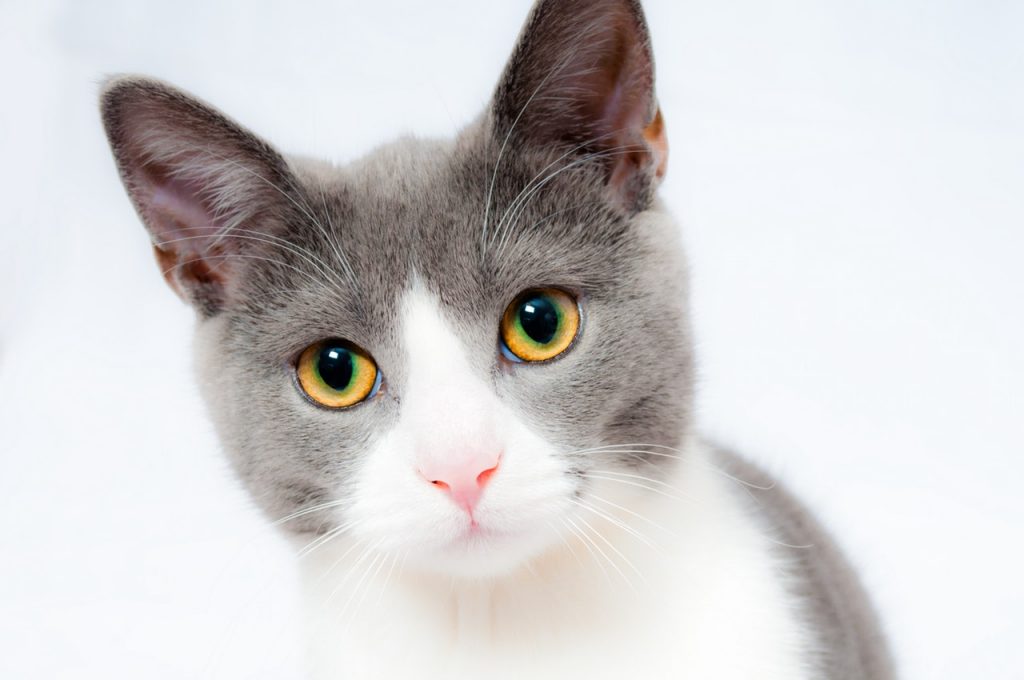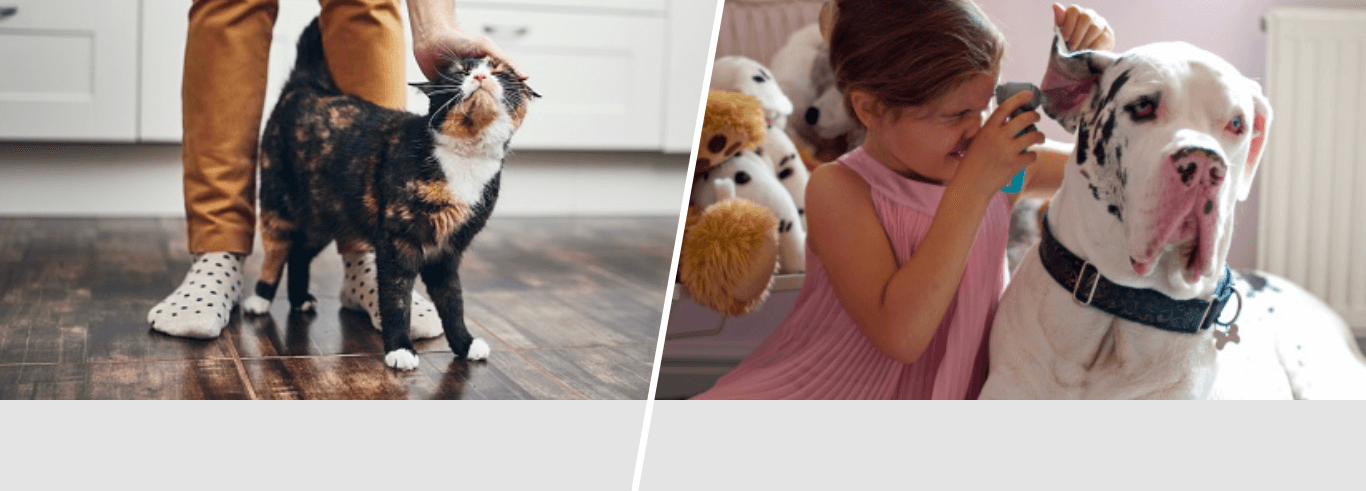How to Care for Your Cat in Cold Weather
It’s important to take additional steps to look after your cat in the cold weather. Although cats are well adapted, they can still become unwell when exposed to extreme weather, if they are not taken extra care of.
1. Check for Frostbite & Hypothermia in Cats
When the temperature drops below 0⁰C, your cat may be at risk of frostbite and hypothermia, especially if they spend prolonged periods outside. If unchecked, hypothermia in cats can lead to serious consequences, so make sure they’re in good physical condition during the winter. Hypothermia and frostbite are two different conditions, but they can often coincide with each other.
Frostbite is a condition where damage is caused to the skin and other tissues, caused by extreme cold. Frostbite is always a serious condition, and symptoms can include:
- Constant shivering
- Pain and swelling
- Brittle skin or skin ulcers
- Blisters on paws
- Dead or black skin
Hypothermia is a below normal body temperature and can be mild or severe. Symptoms of hypothermia can include:
- Shallow breathing
- Decreased rectal temperature
- Stiffened muscles
- Cold feet and ears
- Fatigue
- Dilated pupils
How to Treat Frostbite & Hypothermia
If you think your cat has frostbite, take them to a warm room and cover them with a blanket. If you believe they may also have hypothermia, cover a hot water bottle in towels and place them near your cat. Make sure to avoid massaging or rubbing your cat to warm them up as this may aggravate their frostbitten skin.
All animals with frostbite require urgent medical attention, so be sure to seek veterinary advice.
2. Should I Dry My Cat After Rain?
Most cats often hate getting wet and will do what they can to avoid the rain, but if your cat enjoys the outdoors even in the cold and wet weather, make sure to dry them immediately if they come in from being in the rain. It’s best to try to persuade your cat to come inside when it is raining, as being caught in a freezing downpour can potentially cause a quick decline in health. But be careful when it comes to drying your cat – it’s often best to rub them down with a dry and fluffy towel. Do not use a hairdryer as it may irritate their skin and also some cats can become aggressive to the loud sound they produce.
3. Introduce a Shelter for Outdoor Cats
Outdoor cats tend to explore the most at night and if they don’t have access to a cat flap, once their owner has gone to bed they can’t get into their warm home until morning. Temperatures are at their lowest in the middle of the night so make sure there is a warm shelter available at all times. If your cat prefers the indoors, make sure they are home and safe before you go to bed. If your cat normally comes back home at night and they have been missing or outside for an extended period of time in extreme weather, as soon as they return make sure to take them to the vet for a health check.
How to Create a Shelter for Outdoor Cats?
A cat shelter outside can simply be a sheltered area such as a shed. You can also create an outdoor shelter using an elevated box or storage container filled with blankets and fabrics which will help absorb moisture, as well as keep your pet dry and warm.
4. Give Your Cat Fresh Water
Do cats need much water? Yes, make sure to regularly replace your pet’s water, especially during cold weather as it is likely to freeze leaving your cat without fresh water. Without fresh water, cats will drink from gutters and puddles, which sometimes contain toxic chemicals, even more so during winter when antifreeze is regularly used.
5. Check Your Vehicle Before You Drive
Why do cats hide under cars? In cold weather, cats will look for warm spots to sleep in if they don’t want to or can’t get inside their home. They tend to find warmth around car engines, so it’s important to check under your car and bonnet for any napping cats before you drive.
You can lure your cat out from under the car with a toy or treat. If they really don’t want to come inside, leave some food and a blanket under the car and remember to check again later as they may have changed their mind.
6. Be Careful with Chemicals
When using antifreeze on your vehicle during colder weather, make sure to keep the chemical liquid away from your pets. The chemical can be deadly and you can poison cats with antifreeze. Your pets don’t know any better and will want to drink it.
If your pet displays the signs of poisoning, which includes loss of balance, vomiting and lethargy, seek help from your vet immediately.
7. Keep Your Cat Active
For cats that are used to heading outside for a wander or a hunt on a daily basis, the cold winter weather can pose a bit of a problem. Cats love warmth and comfort, so many might choose to stay inside more often to avoid winter’s chill. This means their exercise levels will inevitably drop. Luckily, there are lots of ways you can keep cats active inside the house, and it often means you get to see a lot more of your feline friends at the same time, which is an added bonus.
Keeping a Cat Indoors
When it comes to keeping your cat indoors during cold weather, you can build in some regular indoor playtime with your cat to make sure they’re getting plenty of exercise. Investing in some cat play furniture or playing chasing and hunting games will help with this. Any games that will get your cats jumping around are great ones to try. Invest in a bit of vertical cat furniture such as scratching posts and towers, then encourage them to chase their favourite toys up and down the towers for an extra activity boost.
Chasing and hunting games keep their minds active as well as their bodies. Try hiding their favourite toys underneath furniture, especially the scented ones, so they can seek them out. You can also use a remote-controlled toy such as a mouse or car to get them chasing and running around.
If your cat is food orientated, try moving their food upstairs or placing it on a higher surface. This will keep them occupied as they hunt out their meals and will also keep them active as they move up and down the stairs or jump onto surfaces. Bear in mind their abilities and do not put food anywhere they could not easily reach.
8. Prevent Overfeeding in Cats
It’s nice to give your cat an edible treat every now and again, but some of these highly processed treats can contribute significantly to weight gain if given too often, especially if your cat is getting less exercise than normal. Try replacing with a catnip toy or their favourite ball to maintain the positive reinforcement without the added calories.
Cats are carnivores meaning their digestive system is built to process a high protein, low carbohydrate diet. To reduce calorie intake, consider a “light” or prescription weight management diet.
Overeating in Cats
If you are free feeding your cat, ensuring that food is consistently available to them, it’s possible that they may overeat. Overeating can be done out of boredom but can also be a behavioural issue, so it is important to be wary of. Whilst you don’t want your cat to overeat, it is similarly important to check they are eating enough. If your cat seems to be losing their appetite during the colder months, this could be bad news for their health.
9. Introduce a new cat or kitten to the family
If your cat is missing his social activities outside during winter, and you have considered getting a second cat before, then why not bring a new cat into the family. This way both cats can socialise together in the safety of the warm indoors.
This might not always be the right option, so it shouldn’t be a decision you make lightly. Cats are social animals, and a new playmate will certainly keep them more active during the winter months and throughout the year. However, cats can also be very territorial which could cause problems when introducing a new cat.
10. Keep them safe and comfortable
Most cats love to be warm and cosy, so make sure that they have a warm bed and comfortable cushions to lay on, this will help keep them insulated during the night. If you have an older cat or a short haired breed, you may want to get a bed that can be placed next to the radiator. For a more agile cat, you could even get them a radiator bed to hang from your radiator to give them their own warm, safe space. You can browse our selection of cat accessories at Argos that include a range of products that could help keep your cat safe and comfortable.
How to Care for an Elderly Cat
Older and short-haired cats are more affected by the cold. Low temperatures can be very painful for pets with arthritis, who may not want to go out. Set up a litter tray indoors for outdoor cats and make private spaces with food and water. This can remove the necessity of going outside. Remember to keep food and litter trays separate, and make sure you have enough feed/litter stations for all of your cats!
Keep an eye of your cat’s general mood and health, just like us, cats can feel the downside to cold weather and dark nights. But if you make sure they are dry, properly-fed and comfortable as much as they can be, your cat should be their usual self during the winter months.
Look after your cat in the cold weather, and all year round. Help protect yourself from vet bills should your cat become injured with Argos Pet Insurance provided by Pinnacle Insurance Ltd. Explore our cat insurance policies today.
References
https://vcahospitals.com/know-your-pet/frostbite-in-cats
 Sorry, our lines are now closed
Sorry, our lines are now closed




